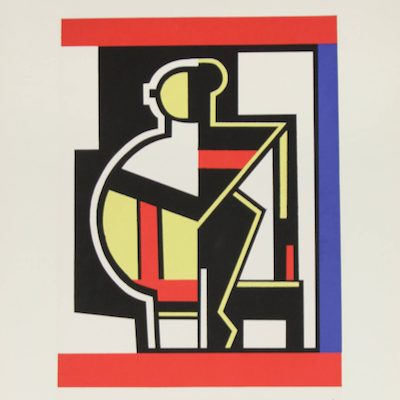


Details
Artist
Styles
Etching and aquatint on Japon Ancien paper - Literature: Cat. rais.: Cramer 86. - It belongs to the book with etchings Trente Ans D'Activité, composed of works by the most recognized artists of the moment, since it was completed on July 4, 1971: Jean Arp, Lynn Chadwick, Marc Chagall, André Dunoyer De Segonzac, Max Ernst, Marino Marini, Henry Matisse, André Masson, Joan Miró, Henry Moore, Pablo Picasso, David Siqueiros, Jaques Villon and Zao Wou-Ki. In addition, the case of the folder that contained them is a design by the Alexander Calder. // Marc Chagall's Composition A L'Horloge, a limited edition etching and aquatint from 1967, exemplifies his poetic and surreal style. Printed on Japon Ancien paper, this artwork merges fantasy with reality, depicting a whimsical clock, a bouquet, and floating figures. The delicate line work and use of aquatint create a textured, dreamlike atmosphere that transports viewers into Chagall’s mystical world. Part of the collection Trente Ans D'Activité, it stands alongside works by other major artists of the time, showcasing Chagall’s consistent ability to evoke emotion and imagination through his signature blend of symbolic and narrative elements.
Composition A L'Horloge, 1967
form
Medium
Size
31 x 24 cm
- Inches
- Centimeters
Edition
Price
- USD
- EUR
- GBP
Details
Artist
Styles
Etching and aquatint on Japon Ancien paper - Literature: Cat. rais.: Cramer 86. - It belongs to the book with etchings Trente Ans D'Activité, composed of works by the most recognized artists of the moment, since it was completed on July 4, 1971: Jean Arp, Lynn Chadwick, Marc Chagall, André Dunoyer De Segonzac, Max Ernst, Marino Marini, Henry Matisse, André Masson, Joan Miró, Henry Moore, Pablo Picasso, David Siqueiros, Jaques Villon and Zao Wou-Ki. In addition, the case of the folder that contained them is a design by the Alexander Calder. // Marc Chagall's Composition A L'Horloge, a limited edition etching and aquatint from 1967, exemplifies his poetic and surreal style. Printed on Japon Ancien paper, this artwork merges fantasy with reality, depicting a whimsical clock, a bouquet, and floating figures. The delicate line work and use of aquatint create a textured, dreamlike atmosphere that transports viewers into Chagall’s mystical world. Part of the collection Trente Ans D'Activité, it stands alongside works by other major artists of the time, showcasing Chagall’s consistent ability to evoke emotion and imagination through his signature blend of symbolic and narrative elements.
- Recently Added
- Price (low-high )
- Price (high-low )
- Year (low-high )
- Year (high-low )
Marc Chagall
Quelle Vie, Quel Plaisir Sans La Blonde Aphrodite? (from In The Land Of The Gods), 1967
Limited Edition Print
Lithograph
USD 21,500
Marc Chagall
Josué Devant Jericho, From La Bible, 1931-39
Limited Edition Print
Mixed Media
Inquire For Price
Marc Chagall
Moïse Fait Jaillir L'eau Du Rocher, From La Bible, 1931-39
Limited Edition Print
Mixed Media
Inquire For Price
Marc Chagall
Das Schwarze Paar Und Der Musikant, 1960
Limited Edition Print
Lithograph
Inquire For Price
Marc Chagall
Quai De La Tournelle, From Regards Sur Paris, 1960
Limited Edition Print
Lithograph
EUR 8,400
Marc Chagall
Philetas's Lesson, From Daphnis And Chloë, 1962
Limited Edition Print
Lithograph
EUR 8,400
Marc Chagall
534. Et Tu Nouais De Ton Tendre Col D'enivrantes Guirlandes De Fleurs Ravissantes. La Myrrhe En Abondance, Préciuse Essence, Digne D'un Roi, Parfumait Ta Tête Bouclée From Sur La Terre Des Dieux, 1967
Limited Edition Print
Lithograph
USD 14,700
Marc Chagall
Jacket Cover For The Lithographs Of Chagall, Volume I, 1960
Limited Edition Print
Lithograph
USD 6,350
Marc Chagall
Menu Pour Une Reception Sur Le Bateau-Mouche, 1959
Limited Edition Print
Lithograph
USD 7,350
Marc Chagall
Bath-Sheba At The Feet Of David, 1958
Limited Edition Print
Etching
EUR 10,000 - 15,000
Marc Chagall
Le Fou Qui Vend La Sagesse (#91), 1927-30
Limited Edition Print
Etching And Aquatint
USD 5,200
What is Cubism?
Cubism is an art movement that aimed to depict multiple perspectives of objects or figures within a single picture. Artists Georges Braque and Pablo Picasso pioneered this style around 1907. The name Cubism emerged from their use of geometric shapes and outlines that often resembled cubes, breaking objects down into abstracted forms.





























































